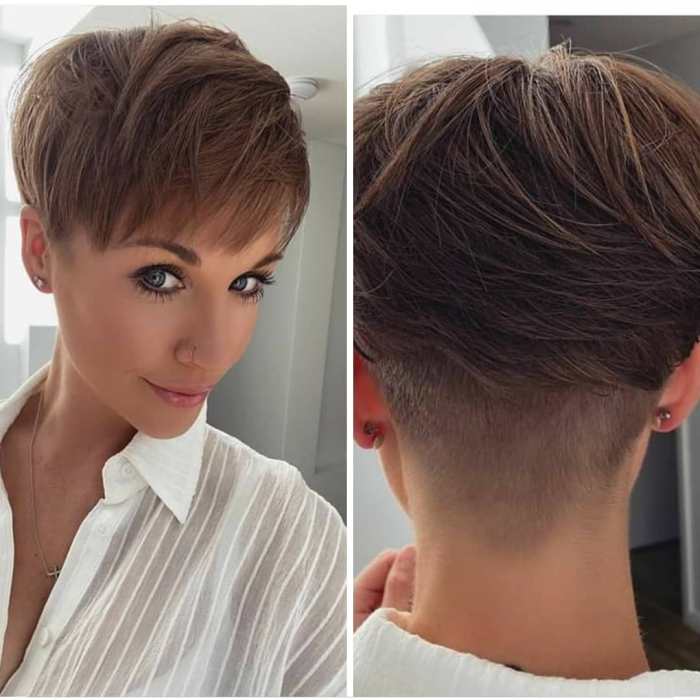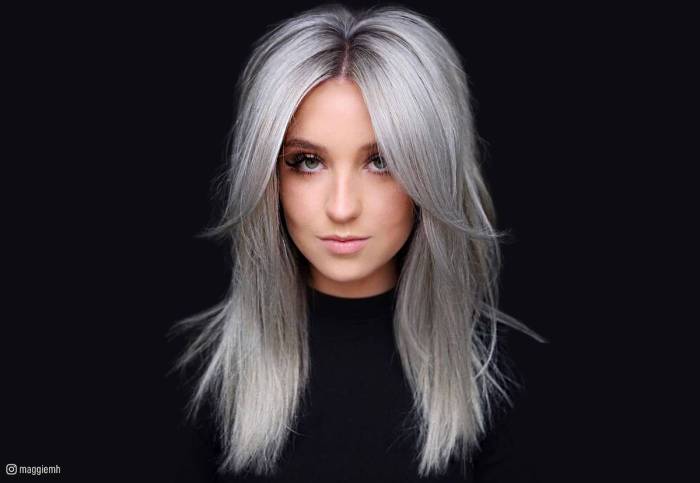Hairstyles for Straight and Thin Hair
Understanding Straight and Thin Hair
Hairstyles for straight and thin hair – Straight and thin hair, while often perceived as simple to style, presents unique challenges. Its delicate nature requires careful handling and specific techniques to achieve desired volume and texture. This section explores the characteristics, common problems, and styling difficulties associated with this hair type.
Characteristics of Straight and Thin Hair

Source: pophaircuts.com
Straight and thin hair is characterized by its lack of natural volume and texture. The individual strands are fine and often appear limp or lifeless. It tends to be less resistant to damage and can be prone to oiliness at the roots.
Finding the right hairstyle for straight, thin hair can be challenging, often requiring techniques to add volume and texture. A surprisingly effective solution, especially for shorter lengths, involves utilizing claw clips to create stylish updos or half-up styles. For inspiration on achieving these looks, check out this helpful guide on claw clip hairstyles for short hair. Ultimately, mastering these techniques can significantly enhance the overall appearance of straight, thin hair, offering a range of versatile and chic options.
Challenges in Styling Straight and Thin Hair
The primary challenge with styling straight and thin hair lies in creating volume and preventing it from appearing flat or lifeless. The fine texture makes it susceptible to damage from heat styling, and achieving long-lasting styles can be difficult.
Common Hair Problems for Straight and Thin Hair
Individuals with straight and thin hair often experience issues such as limpness, lack of volume, oiliness at the roots, and susceptibility to breakage. These problems are often exacerbated by improper styling techniques or the use of harsh hair products.
Hairstyle Options for Volume and Texture
Several hairstyles can effectively add volume and texture to straight and thin hair. Careful selection, combined with appropriate styling techniques, can significantly enhance the overall appearance. The following table Artikels some suitable options.
| Hairstyle Name | Description | Best Face Shape | Styling Tips |
|---|---|---|---|
| Layered Bob | A classic cut with varying lengths that creates movement and volume. | Oval, Round, Square | Use texturizing products for added lift and definition. |
| Long Layers with Face-Framing | Longer layers throughout the hair with shorter pieces around the face add dimension and movement. | Oval, Heart | Employ a volumizing mousse at the roots before blow-drying. |
| Pixie Cut | A short, choppy cut that adds texture and creates a bold look. | Oval, Heart | Use a texturizing spray for added definition and separation. |
| Voluminous Ponytail | A high ponytail, teased at the crown, creates a voluminous and sophisticated look. | Most face shapes | Backcomb the crown section for added volume before securing the ponytail. |
Achieving a Voluminous Ponytail
To achieve a voluminous ponytail, begin by backcombing the crown section of your hair gently. Apply a volumizing mousse or spray for extra lift. Gather your hair into a high ponytail and secure it with an elastic band. For extra volume, you can wrap a strand of hair around the elastic band and secure it with a bobby pin.
Layered vs. Blunt Cuts for Thin Straight Hair, Hairstyles for straight and thin hair
Layered haircuts create movement and the illusion of volume by adding varying lengths. Blunt cuts, while sleek, can sometimes emphasize the thinness of the hair. Layered cuts are generally preferred for adding volume and texture to thin, straight hair.
Styling Techniques and Products
The right styling techniques and products can significantly impact the look and feel of straight and thin hair. This section explores effective methods and product choices.
Using Volumizing Mousse or Root Lift Spray
Apply volumizing mousse or root lift spray to damp hair, focusing on the roots. Gently massage the product into the scalp to lift the hair from the roots. Then, blow-dry your hair, using a round brush to lift and shape the strands. For extra volume, use a diffuser attachment.
Benefits and Drawbacks of Hair Styling Products
Serums can add shine and smoothness, but may weigh down fine hair. Sprays provide hold and texture, but overuse can lead to build-up. Mousses add volume and lift, but should be used sparingly to avoid stiffness.
Using Heat Styling Tools Safely
Always use a heat protectant spray before using any heat styling tools. Avoid excessive heat and prolonged exposure, as this can damage thin, straight hair. Use lower heat settings whenever possible.
Hairstyles for Specific Occasions
This section details hairstyles suitable for various occasions, focusing on practicality and ease of creation.
Formal Event Hairstyles
A sleek low bun, an elegant updo with braids, and soft waves created with a curling iron are all versatile formal hairstyles easily achieved with common tools and products. The sleek low bun requires only hair ties and bobby pins; the updo can incorporate a simple braid; and soft waves can be achieved with a curling iron and hairspray.
Simple Everyday Hairstyle
A simple, low side braid is a quick and effortless everyday hairstyle that adds a touch of elegance without requiring extensive styling. It keeps hair out of the face and adds a subtle touch of texture and volume.
Hairstyles for Different Face Shapes
- Oval: Most styles suit oval faces.
- Round: Layered cuts and styles with height add length and definition.
- Square: Soft waves and layers around the face soften angles.
- Heart: Styles that add volume at the bottom balance the wider forehead.
Hair Care Routines for Healthy Hair
A consistent hair care routine is crucial for maintaining the health and appearance of straight and thin hair.
Importance of Regular Trimming
Regular trimming removes split ends and prevents breakage, promoting healthy hair growth. Aim for a trim every 6-8 weeks.
Hair Care Routine for Growth and Strength
A routine should include gentle cleansing with a volumizing shampoo, followed by a moisturizing conditioner. Use a leave-in conditioner for added hydration and protection. Consider incorporating a hair mask once a week for deep conditioning.
Proper Washing and Conditioning
Wash your hair with lukewarm water, avoiding hot water which can strip natural oils. Massage the shampoo gently into the scalp, avoiding harsh scrubbing. Apply conditioner from mid-lengths to ends, focusing on the drier areas. Rinse thoroughly with cool water to seal the hair cuticles.
Illustrative Examples of Hairstyles
This section provides detailed descriptions of various hairstyles suitable for straight and thin hair.
Bob Haircut

Source: latest-hairstyles.com
A bob haircut, particularly a layered bob, is a versatile choice for thin, straight hair. The layers add texture and movement, preventing the hair from appearing flat. Variations include a classic A-line bob, a graduated bob, or a textured bob. Styling options range from sleek and straight to slightly wavy or tousled.
Pixie Cut
A pixie cut, with its short, choppy layers, adds volume and texture to thin straight hair. The cut can be customized to flatter different face shapes, with strategic layering around the face to create a frame. Styling involves using texturizing products and a light-hold hairspray for definition and hold.
Long Layered Hairstyle
Long layered hairstyles, particularly those with face-framing layers, create movement and volume in thin straight hair. The layers should be strategically placed to avoid making the hair look thin at the ends. Styling involves using volumizing products at the roots and a large round brush during blow-drying to add lift and shape.
Expert Answers: Hairstyles For Straight And Thin Hair
Can I use dry shampoo on straight, thin hair?
Yes, dry shampoo can add texture and volume, but use sparingly to avoid a stiff or unnatural look. Focus on the roots.
How often should I wash my thin, straight hair?
Every other day or every two days is generally recommended to avoid over-stripping natural oils, which can lead to limp hair.
Are bangs a good choice for thin, straight hair?
Side-swept bangs can add volume and dimension, but avoid heavy, blunt bangs which can make hair look thinner.
What’s the best way to prevent breakage?
Use a wide-tooth comb, avoid harsh brushing, and opt for gentle hair ties and clips.




















